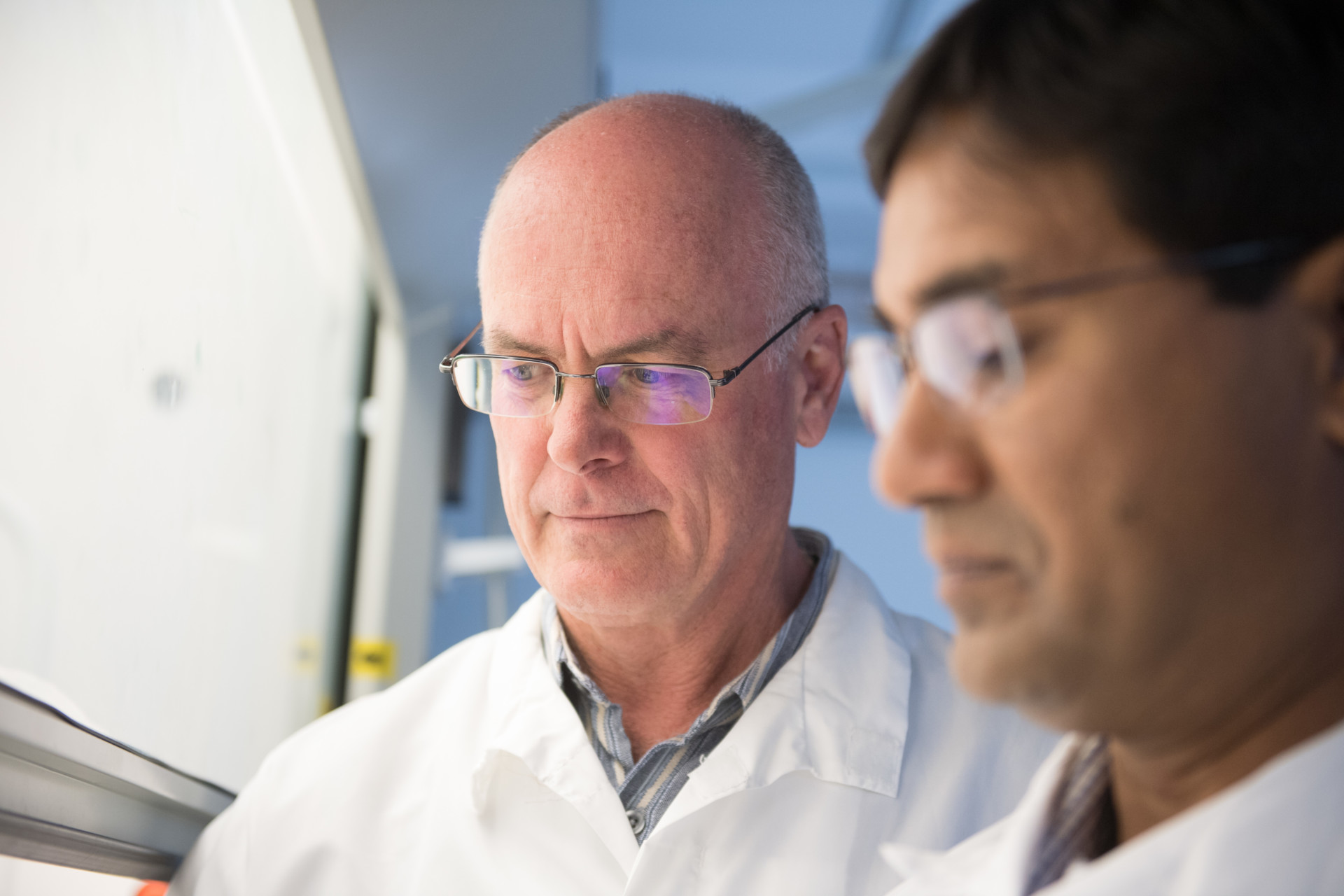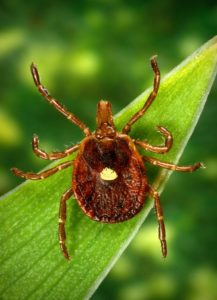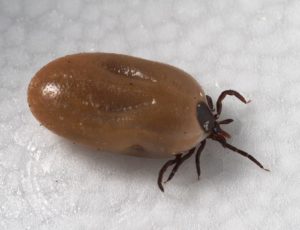
John Belisle (left) and Nurul Islam at the Biomolecular Analysis Core on CSU’s Foothills campus. Photo: John Eisele/CSU Photography
Lyme disease is the most commonly reported vector-borne illness in the United States, but it can be confused with similar conditions, including Southern Tick-Associated Rash Illness (STARI). A team of researchers led by Colorado State University has identified a way to distinguish Lyme disease from similar conditions, according to a new study published Aug. 16 in Science Translational Medicine.
Senior author John Belisle, a professor in CSU’s Department of Microbiology, Immunology and Pathology, said the findings are significant.
“We were able to tell the difference between early Lyme disease and Southern Tick-Associated Rash Illness by using biomarkers that show us how the body reacts to these illnesses,” Belisle said. “This could be important in helping to more accurately detect early Lyme disease, which is crucial because the longer people wait for Lyme disease treatment, the higher the potential risk for having more severe symptoms.”
Fast facts: Lyme disease
In 2015, 95 percent of confirmed Lyme disease cases were reported from 14 states:
Connecticut, Delaware, Maine, Maryland, Massachusetts, Minnesota, New Hampshire, New Jersey, New York, Pennsylvania, Rhode Island, Vermont, Virginia and Wisconsin.
SOURCE: Centers for Disease Control and Prevention
The research team, which also included scientists from the Centers for Disease Control and Prevention, hopes the findings will lay the groundwork for other studies that could lead to better early testing for Lyme disease.
Lyme disease versus STARI

Current laboratory tests aren’t sensitive enough to detect Lyme disease infection with high accuracy in the first few weeks of illness. Adding to the complexity, researchers have yet to identify what pathogen causes STARI, which presents a rash and other symptoms nearly indistinguishable from that of Lyme disease: fatigue, fever, headache, and muscle pains. STARI cannot be diagnosed with the current test for Lyme disease.
The geographic boundaries of both diseases are expanding and will overlap even more in the years to come, making the need for a more accurate early test for Lyme disease all the more urgent.
The researchers used mass spectrometry to identify biomarkers of metabolic differences in the two diseases. In doing this, they were able to differentiate early Lyme disease from STARI with an accuracy of up to 98 percent.
Proper diagnosis of Lyme disease important

An estimated 300,000 cases of Lyme disease occur annually in the U.S., with most of the cases occurring in the northeast and upper Midwest. In 2015, 95 percent of confirmed Lyme disease cases were reported from 14 states (see sidebar). Lyme disease is transmitted when blacklegged ticks infected with the bacterium Borrelia burgdorferi bite people. Lone star ticks, which cause STARI, do not transmit B. burgdorferi.
People with untreated Lyme disease may experience a fever, rash, facial paralysis, and arthritis. More severe long-term symptoms include severe headaches, heart palpitations or an irregular heartbeat, nerve pain, problems with short-term memory and inflammation of the brain and spinal cord.
“It is extremely important to be able to tell a patient they have Lyme disease as early as possible so they can be treated as quickly as possible,” said Claudia Molins, first author of the study and a microbiologist in the CDC’s Division of Vector-Borne Diseases. “Most Lyme disease infections are successfully treated with a two- to three-week course of oral antibiotics.”
Molins has a doctorate in microbiology from CSU.

Researchers have also found that Lyme disease-related health care costs are huge. In a 2015 report published in PLOS ONE, a team from the Johns Hopkins Bloomberg School of Public Health found that Lyme disease costs the U.S. health-care system between $712 million and $1.3 billion a year in return doctor visits and testing.
CSU tuberculosis, leprosy research offers insight
Belisle saw that the approaches his team has taken with tuberculosis and leprosy — developing biomarkers or biosignatures for diagnosing a disease or the prognosis for a disease — could be applied to developing a diagnostic test for STARI and improving Lyme disease diagnostic tests.
“We have found that all of these infections and diseases are associated with an inflammatory response, but the alteration of the immune response and the metabolic profiles aren’t all the same,” Belisle said.
Metabolic pathways are a linked series of chemical reactions occurring within a cell. “To some extent, your metabolism is going to change based on what your ailments are,” Molins explained. The studies performed were based on this idea that unique metabolic differences are associated with an illness or disease. The research team looked at metabolites, very small molecules produced by the body that include things like sugars, peptides, amino acids, and lipids.
Fine-tuning the test for broader use
Next steps for the team include developing a test that could be used in a diagnostic lab, outside of a research setting.
“The focus of our efforts is to develop a test that has a much greater sensitivity, and maintains that same level of specificity,” Belisle said. “We don’t want people to receive unnecessary treatment if they don’t have Lyme disease, but we want to identify those who have the disease as quickly as possible.”
In the longer-term, Belisle said researchers also hope to monitor how patients respond to treatment.
Study coauthors also include researchers from New York Medical College and the Burnett School of Biomedical Sciences at the University of Central Florida.